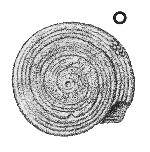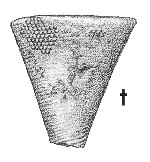
Revised descriptions of New Zealand Cenozoic Mollusca from Beu and Maxwell (1990)

 | Revised descriptions of New Zealand Cenozoic Mollusca from Beu and Maxwell (1990) | 
|
  (Pl. 8o): holotype, probably from Lorne, near Oamaru, Kaiatan (AMTM 201, Auckland Museum) |
  (Pl. 8t): holotype, probably from Lorne, near Oamaru, Kaiatan (AMTM 201, Auckland Museum) |
Beu & Maxwell (1990): Chapter 8; p. 124; pl. 8 o, t.
Synonymy: Conus (Lithoconus) triangularis Finlay 1924b, p. 479 (not Conus berghausi Michelotti var. triangularis Sacco, 1894); Conus trigonicus Tomlin 1937, p. 206 (new name for C. triangularis Finlay, preoccupied)
Classification: Conidae: Coninae
Description: Rather small for family (height 16-25 mm), conical, spire flat or very depressed. Protoconch riot known. Teleoconch of about 6 whorls, periphery sharply angled, sides of last whorl straight or slightly concave. Sculpture of low, narrow spiral cords present over whole surface in some shells, but absent from parts of the last whorl on others. Aperture narrow, inner and outer lips parallel.
Comparison: Conus trigonicus is readily distinguished from other New Zealand cones by its very depressed or even flat spire, its relatively broad shape and its relatively prominent spiral sculpture. C. abruptus (Otaian-Altonian, Pakaurangi) also has a very depressed spire, but it is more slender than C. trigonicus and has far less prominent and less ubiquitous spiral sculpture. As Finlay (1924b, p. 479) pointed out, C. trigonicus seems to be most closely related to C. dennanti Tate, 1892 (mid-Cenozoic, Victoria).
Cone shells are among the most characteristic molluscs of present-day tropical or subtropical seas, although a few species are present in cooler waters (e.g. Victoria; northern New Zealand). The earliest definite New Zealand record of the family is from the Bortonian (Hampden Beach); at least three species are known from the Kaiatan and Runangan, but there are very few records from the Landon Series (see Pl. 15k, n). Cones are relatively common and diverse from Otaian to Clifdenian and rather less so from Lillburnian to Kapitean. Thereafter the family almost completely disappears from the fossil record, presumably because of late Cenozoic cooling. C. trigonicus seems to be a member of the low-spired species group that has been shown in several recent papers to constitute the genus Conus sensu stricto (Duda & Kohn 2005; Bandyopadhyay et al. 2008; Puillandre et al. 2008).
Distribution: Kaiatan; type supposedly from "tuffs below the limestone", Kakanui, but almost certainly from the Waiareka Volcanic Formation, Lorne, where this species occurs rarely (Maxwell 1968).
Cite this publication as: "A.G. Beu and J.I. Raine (2009). Revised
descriptions of New Zealand Cenozoic Mollusca from Beu and Maxwell (1990). GNS
Science miscellaneous series no. 27."
© GNS Science, 2009
ISBN
978-0-478-19705-1
ISSN 1177-2441
(Included with a PDF facsimile file
copy of New Zealand Geological Survey Paleontological Bulletin 58 in CD version
from: Publications Officer, GNS Science, P.O. Box 30368 Lower Hutt, New
Zealand)